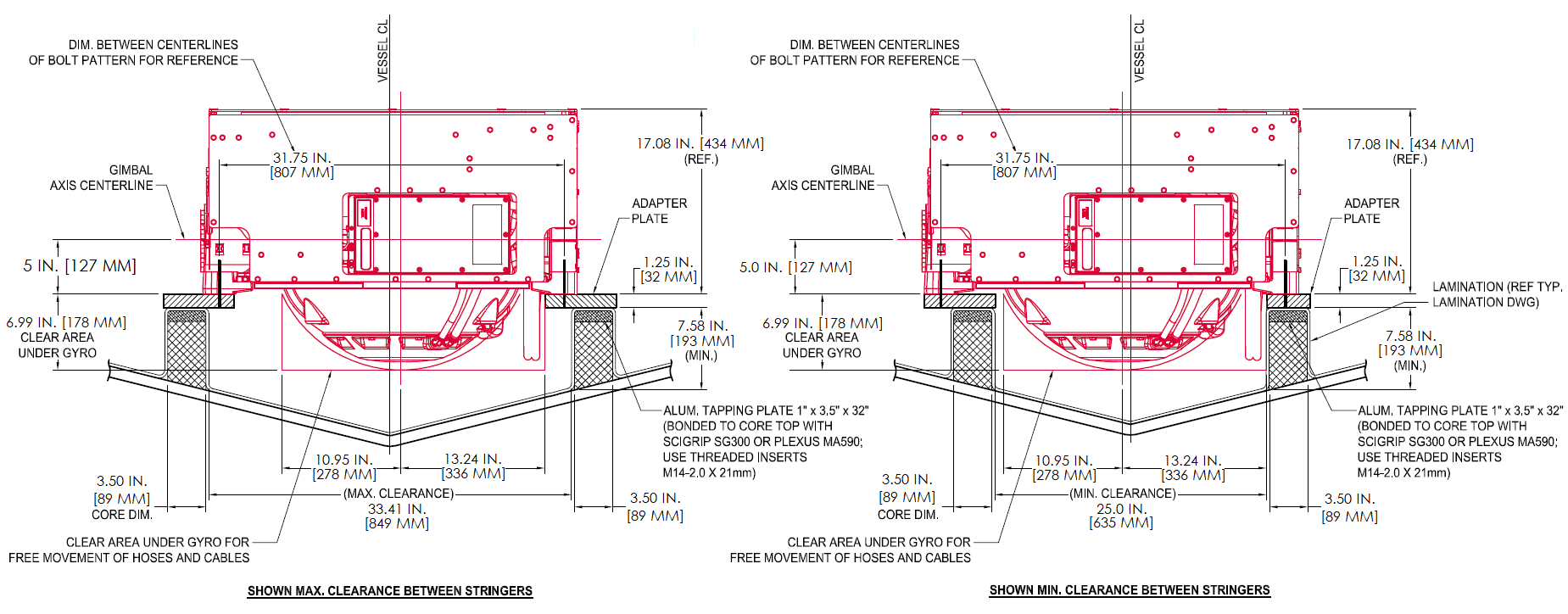Seakeeper 10 Installation Manual (90841-1)
2.3.1 Preparation of Vessel Structure
Seakeeper provided mounting hardware is intended to apply to typical installation arrangements. However, each installation, especially custom aftermarket foundations, should be thoroughly reviewed to ensure the provided hardware meets the required thread engagement for the Seakeeper unit being installed. The mounting bolt thread engagement requirements are outlined in the Installation Manuals and Installation Details Drawings for each Seakeeper model. This also applies to Seakeeper model adapter kits and OEM built frames where the bolt hole depth should be checked to ensure the bolts will not bottom, preventing the bolts from achieving the intended preload.
When the Seakeeper provided hardware is not appropriate, the bolt specification (diameter and thread pitch) and grade should be matched in the required length and used with the Seakeeper provided washers. Mounting bolts should always be torqued to the Seakeeper specification. All Seakeeper provided bolts are metric course thread. Hardware specifications are also listed in the Installation Manuals and Installation Details Drawings.
Refer to Seakeeper Drawing No. 90834 – Seakeeper 10 Bolt-In Installation Details. Important dimensional and load information is given in this drawing that will impact the design details of the structure that will receive the Seakeeper. It is assumed that a proper structural analysis has been performed for the hull structure to which the Seakeeper will be fastened to ensure proper strength margins for the loads the Seakeeper will create during operation. Seakeeper recommends a safety factor of 3.0.
Marine-grade aluminum (6061-T6, or equivalent) bar stock is recommended for both blind hole tapping and thru-bolt installations. For blind-hold installations, helical threaded inserts (Helicoils) with a length of 1.5 x bolt-diameter (21 mm) are required to ensure the strength of the tapped holes exceeds that of the mounting bolts (Grade 10.9), which ensures a secure bolted connection between the Seakeeper and hull structure.
The Seakeeper supporting structure should be parallel to the vessel waterline, with up to 2 degrees of allowance for trim. It must be installed in a fore- and aft orientation parallel to the vessel centerline.
In addition, the four areas on top of the structure on which the Seakeeper frame and isolation gaskets will rest need to be co-planar within .06 in. (1.5 mm) to minimize potential distortion of the Seakeeper support frame when installed. The isolation gaskets are only used when the Seakeeper 10 is mounted to a dissimilar metal structure.
Seakeeper provides an installation template kit, P/N 90839, which contains plates matching the mating surfaces of the four feet on the Seakeeper’s frame. These plates have 4 holes located at the same centers as the mounting holes on the Seakeeper. The fixture locates the hole patterns at the proper spacing both in the forward-aft direction and the port-starboard direction. See Figure 6 below. Once assembled, the fixture can be used to check clearances and alignment of the hull structure.
Note: Do NOT use the installation fixture to establish Seakeeper envelope dimensions. Refer to Drawing No. 90834 – Seakeeper 10 Bolt-In Installation Details, for envelope dimensions. A 3-D model of the Seakeeper is available on the Seakeeper Technical Library (www.seakeeper.com/technical-library/) to aid in designing the Seakeeper foundation and the space around the Seakeeper.
NOTE: MAKE SURE NO OBSTRUCTIONS FROM THE HULL STRUCTURE CAN BE SEEN WITHIN THE INSIDE OF THE INSTALLATION TEMPLATE KIT (INSIDE THE MARKED RED LINES) AS SEEN IN FIGURE 6. REFERENCE SEAKEEPER DRAWING NO. 90834 – SEAKEEPER 10 BOLT-IN INSTALLATION DETAILS.


CAUTION: Tight clearances from cable guide bands to hull structure.
See above figure for dimensions and reference Seakeeper Drawing No. 90834 – Seakeeper 10 Bolt-In Installation Details for complete Seakeeper 10 envelope.